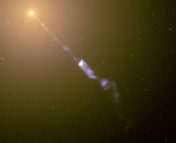Over three days this week, we’ll be celebrating this year’s astronomical awardees for the Nobel Prize in Physics: Roger Penrose, Reinhard Genzel, and Andrea Ghez.
Last Tuesday, the 2020 Nobel Prize in Physics was announced. This year’s prize went to Roger Penrose, Reinhard Genzel & Andrea Ghez. Yesterday’s bite took a look at the work of Andrea Ghez, the fourth woman ever to win a Nobel Prize in Physics, and tomorrow’s bite will look at the work of Roger Penrose. Today’s bite takes a look at the pioneering work of Reinhard Genzel.

Reinhard Genzel was born in Bad Homburg vor der Höhe, Germany. He studied physics at the University of Freiburg and the University of Bonn where he did his PhD in 1978. His PhD thesis was in radioastronomy at the Max Planck Institute for Radio Astronomy. Genzel was then a Miller Fellow at the Harvard-Smithsonian Centre for Astrophysics in Cambridge, Massachusetts from 1980-1982 as well as an Associate and eventually Full Professor at the Department of Physics at the University of California, Berkeley. In 1986, Genzel left Berkeley to move back to Germany and become a director at the Max Planck Institute for Extraterrestrial Physics (MPE) in Garching, Germany, where he leads the Infrared & Submillimeter group. He is also an Honorary Professor at Ludwig-Maximilians-Universität München (LMU) since 1988 and 1999, he also holds a part-time joint appointment as Full Professor at the University of California, Berkeley.
Many scientists have been involved in various stages of the observations and analysis of the Galactic Centre, but a leading pioneer in this field is Reinhard Genzel. Genzel, who leads the Galactic Centre Group, was just awarded a Nobel Prize for his work determining what exactly is residing in the very centre of our galaxy. Spoiler alert… it’s a massive black hole!
Condensing all of the group’s work over the years into one article would be more of a three-course dinner than a ‘bite’, so today’s Astrobite attempts to give a brief history of the significant steps that brought us to what we know today.
The video below showcases the remarkable detail we know about the Galactic Centre. Knowing the 3D positions allows the Galactic Centre Group at MPE to make this video showing the positions of the stars in the nuclear star cluster surrounded the centre black hole.
In 1996, Eckart & Genzel presented a Nature letter detailing observations of stars around the Galactic Centre, which are practically hidden behind interstellar dust at optical wavelengths, but become visible in the near-infrared regime. Of course, when looking for black holes, it’s extremely difficult to tell that they’re there, unless they are accreting a lot of material or interacting gravitationally with their environment. In a similar way we can tell that it’s windy outside when we see the trees swaying: We can’t see the wind, but we can see its effect. In this work, Eckart & Genzel presented the proper motion of 39 stars located between 0.04 and 0.4pc (around 8000-80000 AU) from the Galactic Centre. The very fast motions of the stars provide strong evidence for a central dark mass of 2.45 ± 0.4 × 106 solar masses, located within 0.015pc of the compact radio source Sgr A*. It’s worth noting here that we discuss Sgr A* as being the massive black hole in the centre of our galaxy, but it was initially named as a bright radio source with no optical counterpart. A lot of work still needed to be done to bring it up to the title of black hole, of which a substantial amount was done by Genzel & collaborators.
Straight away, a few other options could be ruled out. One of the considerations was that the motions of the stars could be altered because they are in binary or multiple star systems. Such stars are gravitationally bound to one or more other stars (or compact objects) and orbit a common centre of mass. But Eckart & Genzel find that this is not possible, as the velocities they measured would require the companion stars to be on order of 104 solar masses, which is physically implausible. Eckart & Genzel conclude in this paper that the central mass is also extremely unlikely to be a cluster of neutron stars or white dwarfs. They do suggest it could potentially be a cluster of 10-20 M⊙ stellar mass black holes, but favour the conclusion of a single massive black hole.
Further evidence for this conclusion piled on when the star ‘S2’ was found to be bound with a highly elliptical orbit around Sgr A* with a period of just around 15 years, as reported by the MPE team in a 2002 letter to Nature. Skipping forwards a few years to 2009, the team presented a full 16 years of high-resolution near-infrared observations, again of the stars in the inner nuclear star cluster. They carefully considered measurement errors and managed to improve the astrometric uncertainties on previous measurements by a factor of 6. A single point mass (a black hole) continued to be the best fit model.
A year later, in a review by Genzel, Eisenhauer & Gillessen, the authors write that what’s residing in the centre of our galaxy must be a massive black hole of about 4.4 × 106 M⊙ ‘beyond any reasonable doubt’. This paper delves further into the properties of the stars around the black hole, and they find extremely interesting and unexpected results. For instance, the observed young massive stars – many of them moving within a disk system – probably formed deep within the sphere of influence of the black hole, which one naively would expect to be a hostile and turbulent environment for star formation. They also take a look at the accretion of the black hole itself. Gas is streaming into the very centre of the galaxy at a substantial rate, however, the current accretion rate onto the black hole itself (past the event horizon) is much lower than theoretically predicted. Other evidence suggests that the black hole used to be a lot more active in the recent past, and the accretion onto the black hole seems to be chaotic. Is this just the case for our black hole or is this true for all galaxies hosting a supermassive black hole (SMBH) at their centre? The authors give strong hints that should there be stars sufficiently close to the central black hole, this may become a test bed for General Relativity in the strong field limit. They end the review with some wisdom:
‘Success is not guaranteed but the goals are extremely rewarding and make the efforts highly worthwhile’
Genzel, Eisenhauer & Gillessen 2010
This brings us to (relatively) modern day. 2018 saw a publication from the GRAVITY Collaboration, detailing even more advancements in observations. This paper focuses again on just the showcase star, ‘S2’. It reached it’s pericentre at 120AU from the black hole (let that sink in… that’s Solar System scales!) with an impressive orbital speed of 7560km/s (2.5% of the speed of light!), such that the first order effects of Special and General Relatively become detectable with the current observational capabilities.

Source: Figure 2 from the 2018 paper from the GRAVITY collaboration
At this point, S2 had been tracked for 26 years using adaptive optics instruments on the ESO VLT, several of which had been designed with these exact observations in mind, but as it approached its pericentre, it was also observed with the new four-telescope interferometric beam-combiner instrument GRAVITY. With these observations, they robustly detect the combined gravitational redshift and relativistic transverse Doppler effect. They find for the first time that the data from this star are inconsistent with pure Newtonian dynamics!
Many puzzles still remain unsolved, but looking back on more than two decades of high-resolution near-infrared observations of the Galactic Center, and looking ahead to the era of next-generation, extremely large telescopes, the Galactic Center will certainly continue to be a unique astrophysical laboratory.
Let’s conclude this bite with an astonishing video from the Galactic Centre Group at MPE, showing a zoom in to the centre of our galaxy. This video truly showcases the remarkable work done by many scientists all over the world to build such a detailed picture of our home, the Milky Way.
Astrobite edited by: Philipp Plewa, with thanks to Philipp for his expertise on this topic
Featured image credit: Nobel Media. Niklas Elmehed.




